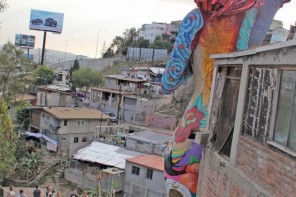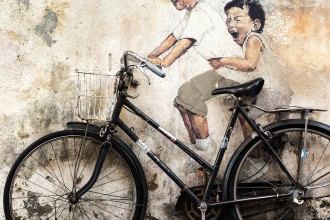Basketery or basket weaving is one of the oldest known crafts, and you’ll find woven baskets in different shapes and sizes in every street market you visit across the world. They’re a wonderful example of utility meets art, and hold a multitude of stories about places and people. Here’s a look at some of our favorites.
Baskets often tell stories about the earth, its forests, meadows and rivers. Take the Bolga basket for example, sturdy, round colorful baskets that come from Bolgatanga, the Savannah grasslands of North East Ghana. The baskets are woven from Guinea grass that grows in the Red Volta river valley, home to elephants, antelope and crocodiles.
While people in Bolgatanga have always woven baskets, they were originally used to strain pito beer made from fermented millet. As global demand for these sturdy baskets grew, they’re now commonly used as market baskets, and are strong enough to hold the heaviest of yams.

Yam seller, Hajjia (left), with a friend in Kejetia Market, said to be the largest in West Africa, in Kumasi, Ghana. Photography by Nyani Quarmyne for Project Bly.
Depending on where you go in Vietnam, you’ll find bamboo baskets in all shapes and sizes and used for a variety of everyday activities. Large baskets with back straps are used to collect grain during the harvest, lidded baskets are used to store grains, and smaller ones used to pack a lunch of sticky rice to take to the field.
In Hanoi, the Old Quarter is organized by craft with each street selling a different craft. These streets correspond to ancient craft guilds which originated and are linked to craft villages surrounding the city. Hang Bo street for example was home to rattan basket weavers who likely originated in the villages of Bang So and Phu Vinh both about 20 miles or so from Hanoi.

(L) Abastos Market (B) Valeria shows us how to weave a basket. Photography by Marcela Taboada for Project Bly
In the State of Oaxaca, San Juan Guelavia not far from the market town of Tlacolula is known for its baskets. Most baskets are made from cornhusks or palm fronds, are simple and utilitarian and used for holding tortillas, fruits and vegetables or storing grain. Mercado Abastos in Oaxaca is a good place to shop for these baskets.
At the Mercado Benito Juarez, the craft market in Oaxaca, Mexico we met the lovely Valeria who hand weaves baskets called tanates de palma from strips of palm leaves. Pretty and functional, the precision of the weaving and geometric perfection of the design is all the more impressive considering that she makes up the designs as she weaves. Valeria hails from the town of Miahutlan de Porfirio Diaz, and learned the art of basket-weaving from her mother, who learned it from her mother.

Guaraní baskets and other market finds from La Paz, Bolivia. Photography by Kelly Ishikawa for Project Bly.
In the department of Tarija located in Southern Bolivia, the Guaraní people are famous amongst other things for their folklore and mad basket weaving skills. These baskets are made with a reed called tankuarans, and are typically woven by men. Found in La Paz, Bolivia, these baskets tell a story of migration. The lowlands are the fertile bread -basket of Boliva, but with the expansion of cash-crop agriculture and the oil and gas industry, its poorest inhabitants have been forced to migrate elsewhere.
In Marrakech, Morocco bread known as khobz is a symbol of hospitality, friendship and generosity, and if invited into a local’s home, you always be offered bread. It’s no surprise then that bread- baskets are found all over Morocco.
Shop baskets from around the world!
Follow us on Pinterest for inspiration on incorporating global market finds into your home.










